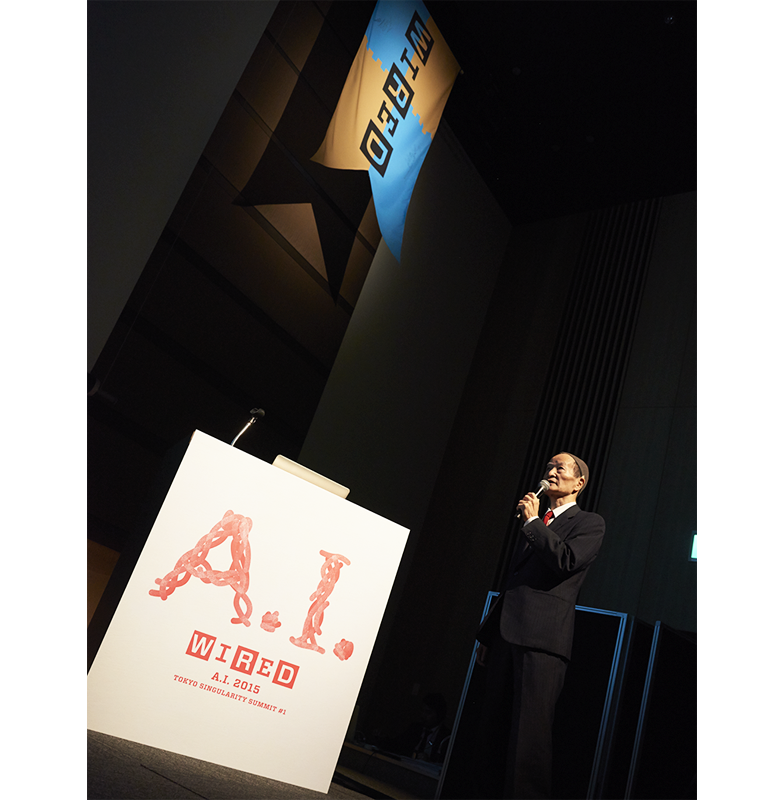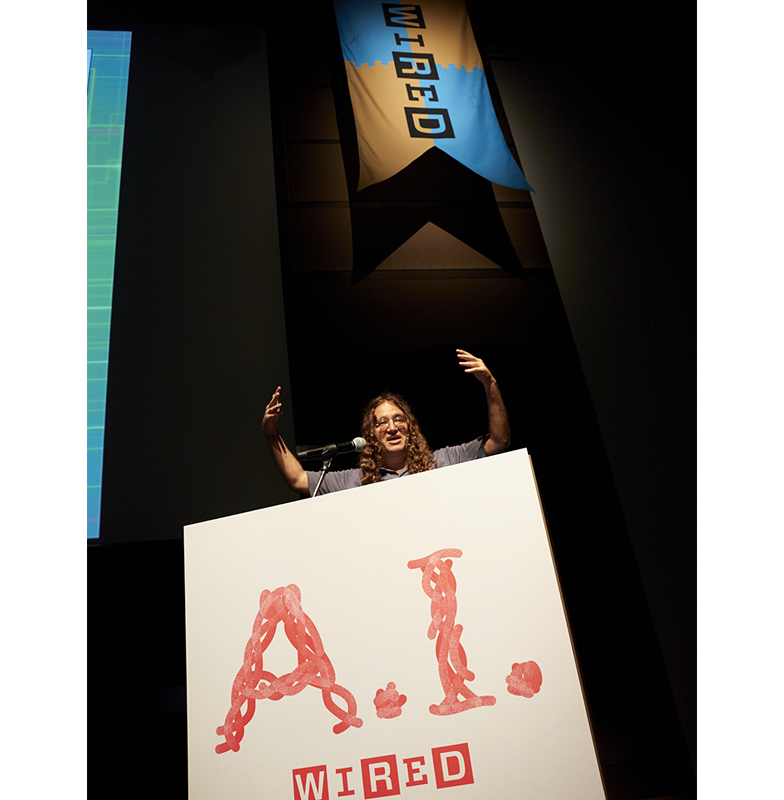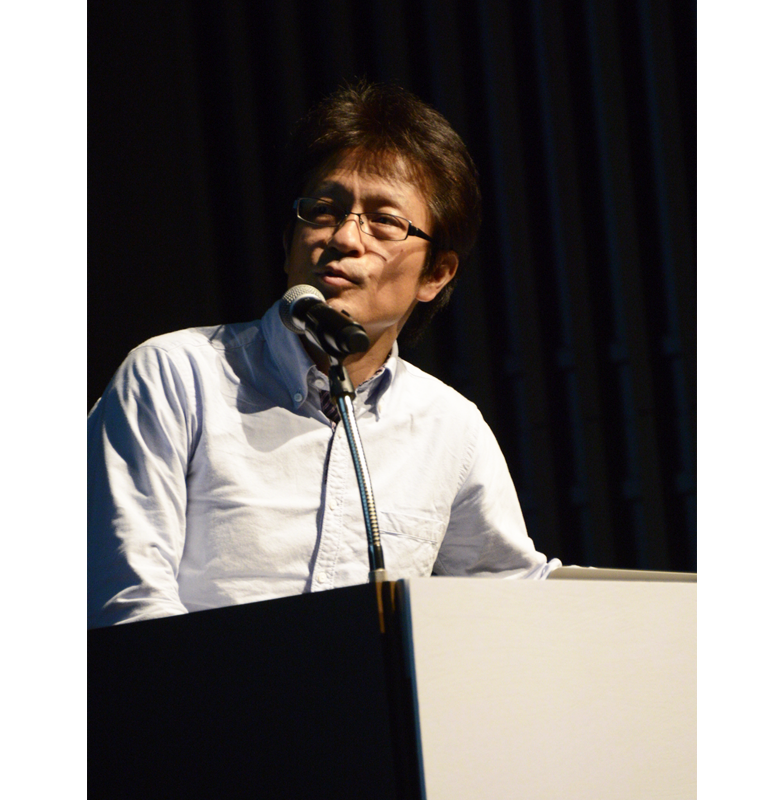WIRED Japan (Condé Nast Japan) held "WIRED A.I. 2015 ~ TOKYO Singularity Summit #1" on September 29 at Toranomon Hills in Tokyo, focusing on artificial intelligence (AI). The event received official support as a co-hosted event with the Ministry of Economy, Trade and Industry.
Against the backdrop of the current "Third AI Boom," tickets sold out quickly. Over 600 enthusiastic attendees packed the venue, including a hastily added satellite location, making it the largest crowd ever for a WIRED Japan event.
We report on several highlights from the event, including related content.
"The Path to Singularity" (Takuya Matsuda, Kobe University)
Professor Matsuda hosts the "Singularity Salon," which inspired this event. His 2012 book, The 2045 Problem: The Day Computers Surpass Humans (Kosaido Shinsho), pioneered serious discussion of the Singularity in popular literature, subsequently popularizing the term "2045 Problem."
Based on Kurzweil's roadmap, he predicts that "Artificial General Intelligence" (AGI) (AGI = Artificial General Intelligence, an AI possessing human-level intelligence capable of passing the Turing Test) would be achieved by 2029, and that the Singularity would occur in 2045 due to "Superintelligence" (an AI surpassing the combined intelligence of all humanity). He emphasized that while countries achieving the Singularity would gain immense power, those left behind would fall into developing nation status, placing Japan in an extremely precarious situation.
This is because the research investment ratio between the US, Europe, and Japan stands at 100:10:1, meaning Japan invests only one-hundredth of what the US does. "If this continues, Japan's defeat is certain," he stated.
However, initiatives capable of turning the tables are emerging in Japan. The report introduced the "Whole Brain Architecture Study Group," "Dwango AI Research Institute," "National Institute of Advanced Industrial Science and Technology (AIST) Artificial Intelligence Research Center," and "PEZY Computing" (which this report will also cover sequentially).
Particularly at "PEZY Computing," led by Motoaki Saito, the realization of an exascale supercomputer (10^18, 100 times larger than a "kio") was presented as feasible. Saito appealed, "Let's trigger the Singularity from Japan," adding, "Since Mr. Saito will build the hardware, I want you young people to create the software (master algorithms)."
"The Future Map of AI Society" (AI Researcher Ben Goertzel)
Dr. Getzell is a leading figure in the AGI community, founding the Artificial General Intelligence Society and the OpenCog Foundation. Born in Brazil (holding dual US and Brazilian citizenship), he is currently based in Hong Kong, working on AI and robotics development.
He also interacts with Japan's AI community. The following day (September 30), he delivered a keynote speech at the "SIG-AGI Founding Symposium" (venue: National Institute of Informatics), a research group under the Japanese Society for Artificial Intelligence launched this year.
He began by noting that while discussing AGI to achieve human-level intelligence in the 80s and 90s made him seem a bit odd, today major corporations and governments espouse this vision, with conferences held worldwide. Though AI is sometimes criticized for achieving little in its 60-year history, considering that culture emerged only 10,000 years ago and the Industrial Revolution just 200 years ago, 60 years is extremely short. In that brief time, AI has been implemented in mobile phones, finance, automobiles, and more, becoming the most critical challenge.
Furthermore, as a roadmap, the median timeframe predicted by experts for AGI realization is 2040, while ASI (Artificial Super Intelligence, likely synonymous with the aforementioned "superintelligence") is projected for 2060. He stated, "I don't think it will take that long from AGI realization to ASI realization, but such minor time differences aren't particularly important. What's remarkable is that experts, not just science fiction enthusiasts, are all discussing this together."
This suggests that among experts, the realization of AGI and ASI is no longer debated as a question of "will it come or not," but rather, a common understanding is emerging that it will come, shifting the discussion to "when it will come."
Returning to the lecture content, regarding the difference between Narrow AI (specialized) and AGI (general-purpose), "specialized" AI requires human programming to solve specific problems, as seen in the progress of AI to date. Current autonomous driving in vehicles falls into this category.
In contrast, "general-purpose AI" is fundamentally different from a collection of specialized systems. It understands meaning and can solve new problems unknown to the programmer, not just specific problems. For example, it refers to systems that can learn to drive not just cars, but also trucks and motorcycles.
While "specialized AI" currently leads academia, "general AI" is becoming a formally recognized field within academic AI research. He announced plans to hold an AGI conference in New York next July.
Getzell also stated his desire to build AGI through an open-source initiative called "OpenCog," likening it to Linux in the operating system world, aiming to create a movement that surpasses large corporations like Google, Facebook, and Baidu.
In any case, he noted that AGI development is accelerating, and he believes it will be realized within his lifetime, stating that we are living in a very exciting era.
"Will General Artificial Intelligence Emerge from an Open Community?" (Hiroshi Yamakawa, Dwango AI Research Institute)
Mr. Yamakawa is the representative of the "Whole Brain Architecture Study Group" and the "Dwango Artificial Intelligence Laboratory," both introduced by Mr. Matsuda. The "Whole Brain Architecture Study Group" was launched in 2013 by three individuals: Mr. Hiroshi Ichisugi from AIST, Mr. Yutaka Matsuo from the University of Tokyo, and Mr. Yamakawa. Both Mr. Ichisugi and Mr. Matsuo serve as visiting researchers at the "Dwango Artificial Intelligence Laboratory."
The Whole Brain Architecture Study Group incorporated as an NPO this August and will now operate as the Whole Brain Architecture Initiative (WBAI), seeking supporting members from companies and other entities.
The aforementioned "General Artificial Intelligence Research Group" (SIG-AGI) was also established primarily by Mr. Yamakawa and Mr. Ryutaro Ichinose of the National Institute of Informatics (NII). It undertakes various initiatives to realize general artificial intelligence in Japan.
Mr. Yamakawa's impetus for starting AGI-related activities in Japan reportedly came from attending the 5th AGI Conference (AGI-12) held in Oxford, UK, in 2012, where Dr. Goertzel served as chair.
He stated, "I recognize 2015 as the year AGI gained global momentum," citing the worldwide start of AGI development, including the recent establishment of GoodAI in the Czech Republic and nnaisense in Switzerland, Google's acquisition of DeepMind which declared its commitment to building AGI, and the founding of WBAI in Japan.
He believes deep learning (a technique that autonomously extracts data features by structuring networks into multiple layers) is indispensable for AGI becoming realistic today. This is because deep learning significantly provided a pathway to solving the long-standing AI challenge of "acquiring representation (cognition/recognition)."
Considering human development, children first acquire skills related to senses and movement, which gradually evolve through narrative and linguistic skills to ultimately reach full human capability.
However, traditional AI excelled at the "adult domain" of computation and handling symbolic information, but struggled with the "child domain" involving expression, such as sensory and motor skills. This is known as "Moravec's Paradox." The major impact of deep learning is that it has enabled the "child domain" (see also the report on Professor Matsuo's lecture below).
Therefore, while previous efforts struggled to descend from the "adult" to the "child" level, research can now progress in a direction aligned with human cognitive development, he stated.
At WBAI, they aim to realize general artificial intelligence through the combination of "machine learning (with advancing techniques integrating deep learning) and cognitive architecture (a blueprint depicting the arrangement of components constituting intelligent agents)." They adopt an approach referencing the brain as an architecture (whole-brain architecture).
This method involves combining machine learning components of artificial intelligence, corresponding to different brain regions involved in cognition, as modules. The presence of an architecture enables distributed collaborative development.
Given AI's significant societal impact and the fact that AI experts alone cannot consider everything, he stated that AGI should be developed within an open community where various experts collaborate, similar to user-generated content (UGC). This is the purpose of WBAI.
We will continue our coverage from "WIRED A.I. 2015 ~ TOKYO Singularity Summit #1" next time.






